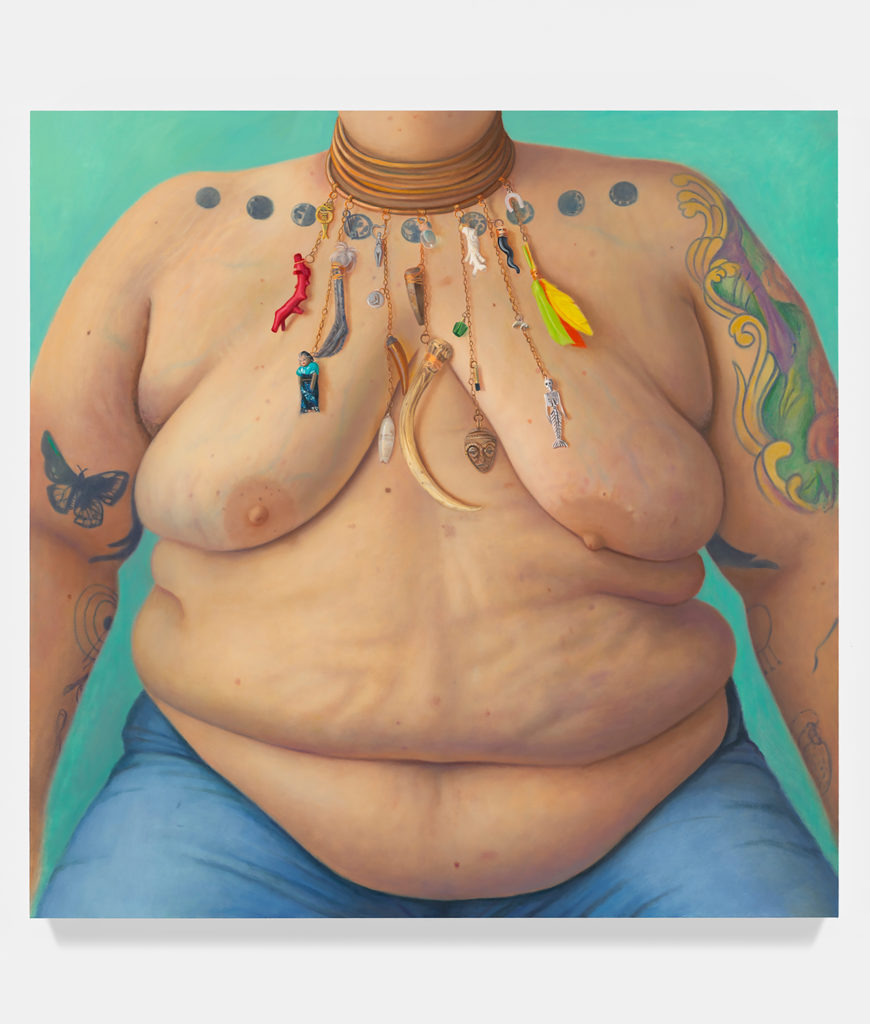
Clarity Haynes
DENNY DIMIN GALLERY
A pair of hairy, pendulous tits and a huge belly marred by stretch marks, drooping skin, fresh bruises, and old wounds: This is a general yet reasonably accurate description of an obese, middle-aged physique—one that belongs to me, a gay man.I see myself reflected in the luminous portraits of nonbinary, trans, and female torsos—fat, scarred, imperfect—by Clarity Haynes. But in her pictures, I don’t find shame or self-loathing—feelings I imagine those with nonnormative bodies, like mine, must struggle with. Obviously, I have no idea what the artist’s models might think about themselves, or how comfortable they are in their own skins. Yet I have a sense of what Haynes feels about them—her affection is deep, abiding, and clear.The figurative oil paintings in Haynes’s exhibition at Denny Dimin Gallery—organized by Benjamin Tischer via his curatorial enterprise, New Discretions—were part of a decades-long project. The artist began painting women’s torsos in earnest sometime after rendering her own, which she did first in 1997 at the age of twenty-six so that she could, in her words, “confront my own traumas.” Haynes doesn’t use photographs as references; people sit for her, and her works often take years to complete. During this process, the artist gets to know her models, listening to their stories of survival, pain, and hope. Top surgeries, mastectomies, birth defects, heart operations: Life is harrowingly and vividly portrayed across all of her canvases. And though her images are wrought with great sensitivity and care, they are never sentimental. Tenderness is evident, palpable—but it is girded by an unflinching take on the human form.Among the most memorable pieces in the show was the looming, sixty-two-inch-square Grace (all works cited, 2019), an unabashed celebration of flesh in all of its formidable, unbounded glory. The titular subject virtually fills the frame of this exquisitely detailed painting. Their neck is encircled by six golden bands, and from one of them hangs an assortment of charms, including bits of red and white coral, a withered bird’s foot, a tiny lucky horseshoe, a mermaid’s skeleton, and what appears to be an enormous, ivory-colored fang. Large breasts are marbled by delicate blue veins; moles and splotches of light pink float upon their surface like celestial bodies. Stretching from shoulder to shoulder is a black-and-white tattoo, an illustration of the moon’s various lunar phases. Grace is a Brobdingnagian deity—a generously conceived image of selfhood and magic that is even grander in spirit.On a nearby wall, almost hidden, were two much smaller portraits in oil on board—Dilma and Brenda—each about the size of a birthday card, but just as vital and eye-catching as the bigger works. The former features the torso of an older black woman wearing an amulet of turquoise, yellow, crimson, and violet—she is poised, elegant. The latter, however, felt funnier and brassier: The sitter’s long, pale breasts are framed by a pair of bright-red suspenders, which complement her rosy nipples. The garters made me think of Barnett Newman’s zips—like moments of vanguard abstraction wrenched out of context and made humble, humorous.Also in the exhibition were several paintings of altars—sacred still lifes festooned with all manner of occult effects, such as stones, candles, pots, and patterned swatches of fabric; reproductions of central core imagery by the legendary feminist artist Judy Chicago; dangling beads and feathers; and a polychromatic array of fuzzy pom-poms connected by a length of yarn. Haynes’s reverential show insisted that all bodies are temples—holy sites that deserve love and adoration.
— Alex Jovanovich

